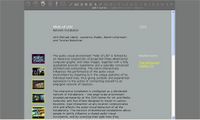Jeffrey Shaw - Installations, Interactivity,Virtuality b (1944) Australia

Jeffrey Shaw's website provides extensive documentation of his projects and collaborations. His work is also documented on the iCinema website.
Projects
Configuring the Cave (1996)
Computergraphic installation with Agnes Hegedues and Bernd Lintermann
iCinema Documentation - Quicktime video clips online
Jeffrey Shaw Documentation - Quicktime video clips online
note new version of this work reconFiguring the CAVE (2001) documented on iCinema

Jeffrey Shaw - ConFIGURING the CAVE
"ConFIGURING the CAVE is constituted by seven differentiated pictorial domains. Movement of the puppets body and limbs dynamically modulate various parameters in the image and sound generating software, while particular postures of the puppet cause specific visual events to occur. Most significantly it is the action of moving the puppet's hands to cover and then uncover its eyes, which causes the transitions from one pictorial domain to the next."
source: http://www.icinema.unsw.edu.au/projects/prj_configcave.html
View video on vimeo
'Web of Life' Network Installation
Network installation with Michael Gleich, Lawrence Wallen, Bernd Lintermann and Torsten Belschner
Jeffrey Shaw Documentation
The web of life installation has its own website http://www.weboflife.de/
Infinity Divided by Sixteen (1987)
Computergraphic/photo installation with Harry De Wit.
Jeffrey Shaw Documentation

Jeffrey Shaw's website provides extensive documentation of his projects and collaborations. His work is also documented on the iCinema website.
Projects
Configuring the Cave (1996)
Computergraphic installation with Agnes Hegedues and Bernd Lintermann
iCinema Documentation - Quicktime video clips online
Jeffrey Shaw Documentation - Quicktime video clips online
note new version of this work reconFiguring the CAVE (2001) documented on iCinema

Jeffrey Shaw - ConFIGURING the CAVE
"ConFIGURING the CAVE is constituted by seven differentiated pictorial domains. Movement of the puppets body and limbs dynamically modulate various parameters in the image and sound generating software, while particular postures of the puppet cause specific visual events to occur. Most significantly it is the action of moving the puppet's hands to cover and then uncover its eyes, which causes the transitions from one pictorial domain to the next."
source: http://www.icinema.unsw.edu.au/projects/prj_configcave.html
View video on vimeo
Configuring the CAVE from UNSW iCinema Centre on Vimeo.
'Web of Life' Network Installation
Network installation with Michael Gleich, Lawrence Wallen, Bernd Lintermann and Torsten Belschner
Jeffrey Shaw Documentation
"The audio-visual environment “Web of Life” is formed by an immersive conjunction of projected three-dimensional computer graphic and video images, together with a fully spatialized acoustic experience and a specially conceived architectural surrounding." source text from documentation of the work oniCinema Documentation - Quicktime video clips online
his website"
The web of life installation has its own website http://www.weboflife.de/
Infinity Divided by Sixteen (1987)
Computergraphic/photo installation with Harry De Wit.
Jeffrey Shaw Documentation
Jeffrey Shaw - Infinity Divided by Sixteen 1987
"A finely perforated projection screen was visibly divided into sixteen sections. Behind each section was a speaker connected to its own amplifier and tape deck. Sixteen sound tracks were composed and recorded by Harry de Wit for this work. Each sound track was assigned to a specific position on the screen, and the volume of each of these sixteen spatially located sound tracks was modulated by a continual analysis of the changing light intensity of the images being projected onto that part of the screen." source text from documentation of the work on his website
